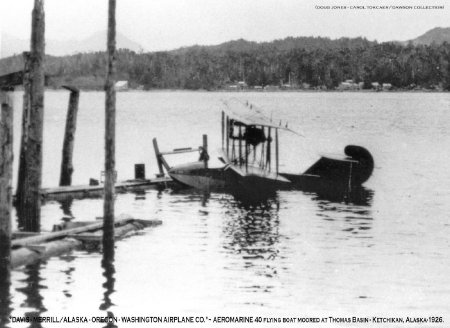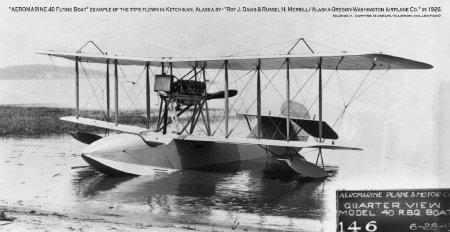Description:
Alaska-Oregon-Washington Airplane Company, 1926
Having tasted a bit of success from their initial hard efforts at establishing a commercial air service in Alaska in 1925, Roy J. Davis and Russel H. Merrill remained resolute in their ambitions, despite the loss of their Curtiss F flying boat. They rolled up their sleeves back in Portland, formulating new plans for making a strong comeback in 1926. The company was renamed as The Alaska-Oregon-Washington Airplane Company.
Test flights were conducted with their modern Curtiss Oriole twin pontoon seaplane to get it ready, while shopping around for another war surplus flying boat as their new workhorse replacement aircraft. With Merrill at the controls and Davis riding along on a May 21 test flight, the Oriole hit a submerged log taking off from the Willamette River. Luckily, the two partners were unscathed, but their only plane was damaged beyond economical repair. They managed to find and purchase a crated, never flown Aeromarine 40B biplane flying boat in Vancouver, B.C., similar to the Curtiss F/MF type. It came fitted with a 180 hp Hispano-Suiza V8 engine and included a spare 150 hp Hispano-Suiza motor. The new plane was assembled and test flown for several weeks, with some improvement modifications added to get it operational and as reliable as possible, to prepare for the stressful rigors of Alaska duty. Planning to again base up in Seward, logistic contracts were negotiated and secured with seven Bristol Bay canneries ahead of departure, made on June 27, 1926.
Davis and Merrill's flight up the coast to reach Ketchikan took them over a week, instead of two days, due to encountering strong headwinds and suffering several mechanical breakdowns along the way, which were remedied thanks to bringing along essential tools and spare parts. After their July 6 arrival, the weather turned sour and a decision was made to layover for several days to remove the Aeromarine's finicky motor and install one of the backup powerplants being shipping up. The U.S. Navy Aerial Mapping Survey tender USS Gannet was then in port with her three planes and provided valuable support to help accomplish the engine swap.
The unexpected delays in their flight itinerary schedule resulted in cancellation of the cannery contracts up north, and relegated having to stay in Ketchikan for the remainder of the season to try drumming up any and all commercial revenue flights locally. The variety of charters included a series of contracted aerial hydropower survey flights to assist construction of two fishing cannery complexes, along with the standard barnstorming market scenarios. But as they'd learned the previous summer, the demand was too slim at the time to generate sufficient profit to support a bush flying outfit in Ketchikan. By the end of fall, the Aeromarine was put into storage in Ketchikan with E. E. Grout. On Nov. 11, Merrill sailed south to return to Portland, and his wife Thyra told the Chronicle newspaper they'd be back the following spring to resume their charter flight service in Ketchikan. On Dec. 3, she and her two sons Dick and Bob also departed to join her husband back home in Oregon.
Russ Merrill got numerous offers from aviation companies in the states and Alaska. In 1927, he signed on as chief pilot for the Anchorage Air Transport, Inc., a solid outfit that operated a fleet of modern reliable radial engine aircraft, with hangars and a large staff. He quickly gained fame as one of Alaska's greatest pilots, and was instrumental in the development of commercial aviation in that region. He went missing during a flight on September 16, 1929. Anchorage's Merrill Field airport and Merrill Pass are named after the legendary flyer. Roy J. Davis stayed in Portland, and flew from the Beaverton Airport, where he ran an aircraft repair shop and flight school. It's unknown whatever became of Davis and Merrill's Aeromarine 40 flying boat stored in Ketchikan. A spare propeller left behind is part of the Tongass Historical Society Collection housed with Ketchikan Museums, and is currently on display in Ketchikan Is... at the Tongass Historical Museum.
Aircraft Specifications:
1919 Aeromarine 40B Flying Boat. 50 built. Construction: Laminated mahogany plywood veneer over wooden frame double-step hull, with fabric covered flying surfaces. Dimensions: Length: 28.9'; Height: 11.5'; Wingspan: 48.6'. Weights: Standard Empty Weight: 2,061 lbs.; Gross Weight: 2,590 lbs. Useful Load: 1,000 lbs. Performance: Airspeed: 80 mph; Service Ceiling: 1,900 ft.; Cruising Radius: 4.5 hrs. Engine: 180 hp Hispano-Suiza V8 Cylinder (in lieu of stock 100 hp Curtiss OXX-6). Occupancy: Pilot: 1; Passengers 3 (modified from original two passengers).
Pilots:
Roy J. Davis and Russel H. Merrill.
Mechanics:
Roy J. Davis and Cyril Krugner.
Test flights were conducted with their modern Curtiss Oriole twin pontoon seaplane to get it ready, while shopping around for another war surplus flying boat as their new workhorse replacement aircraft. With Merrill at the controls and Davis riding along on a May 21 test flight, the Oriole hit a submerged log taking off from the Willamette River. Luckily, the two partners were unscathed, but their only plane was damaged beyond economical repair. They managed to find and purchase a crated, never flown Aeromarine 40B biplane flying boat in Vancouver, B.C., similar to the Curtiss F/MF type. It came fitted with a 180 hp Hispano-Suiza V8 engine and included a spare 150 hp Hispano-Suiza motor. The new plane was assembled and test flown for several weeks, with some improvement modifications added to get it operational and as reliable as possible, to prepare for the stressful rigors of Alaska duty. Planning to again base up in Seward, logistic contracts were negotiated and secured with seven Bristol Bay canneries ahead of departure, made on June 27, 1926.
Davis and Merrill's flight up the coast to reach Ketchikan took them over a week, instead of two days, due to encountering strong headwinds and suffering several mechanical breakdowns along the way, which were remedied thanks to bringing along essential tools and spare parts. After their July 6 arrival, the weather turned sour and a decision was made to layover for several days to remove the Aeromarine's finicky motor and install one of the backup powerplants being shipping up. The U.S. Navy Aerial Mapping Survey tender USS Gannet was then in port with her three planes and provided valuable support to help accomplish the engine swap.
The unexpected delays in their flight itinerary schedule resulted in cancellation of the cannery contracts up north, and relegated having to stay in Ketchikan for the remainder of the season to try drumming up any and all commercial revenue flights locally. The variety of charters included a series of contracted aerial hydropower survey flights to assist construction of two fishing cannery complexes, along with the standard barnstorming market scenarios. But as they'd learned the previous summer, the demand was too slim at the time to generate sufficient profit to support a bush flying outfit in Ketchikan. By the end of fall, the Aeromarine was put into storage in Ketchikan with E. E. Grout. On Nov. 11, Merrill sailed south to return to Portland, and his wife Thyra told the Chronicle newspaper they'd be back the following spring to resume their charter flight service in Ketchikan. On Dec. 3, she and her two sons Dick and Bob also departed to join her husband back home in Oregon.
Russ Merrill got numerous offers from aviation companies in the states and Alaska. In 1927, he signed on as chief pilot for the Anchorage Air Transport, Inc., a solid outfit that operated a fleet of modern reliable radial engine aircraft, with hangars and a large staff. He quickly gained fame as one of Alaska's greatest pilots, and was instrumental in the development of commercial aviation in that region. He went missing during a flight on September 16, 1929. Anchorage's Merrill Field airport and Merrill Pass are named after the legendary flyer. Roy J. Davis stayed in Portland, and flew from the Beaverton Airport, where he ran an aircraft repair shop and flight school. It's unknown whatever became of Davis and Merrill's Aeromarine 40 flying boat stored in Ketchikan. A spare propeller left behind is part of the Tongass Historical Society Collection housed with Ketchikan Museums, and is currently on display in Ketchikan Is... at the Tongass Historical Museum.
Aircraft Specifications:
1919 Aeromarine 40B Flying Boat. 50 built. Construction: Laminated mahogany plywood veneer over wooden frame double-step hull, with fabric covered flying surfaces. Dimensions: Length: 28.9'; Height: 11.5'; Wingspan: 48.6'. Weights: Standard Empty Weight: 2,061 lbs.; Gross Weight: 2,590 lbs. Useful Load: 1,000 lbs. Performance: Airspeed: 80 mph; Service Ceiling: 1,900 ft.; Cruising Radius: 4.5 hrs. Engine: 180 hp Hispano-Suiza V8 Cylinder (in lieu of stock 100 hp Curtiss OXX-6). Occupancy: Pilot: 1; Passengers 3 (modified from original two passengers).
Pilots:
Roy J. Davis and Russel H. Merrill.
Mechanics:
Roy J. Davis and Cyril Krugner.


